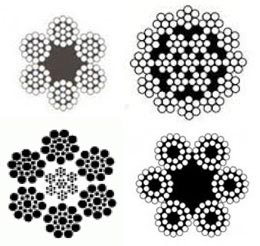 Wire ropes are essential to various industries, such as construction, mining, marine, and transportation. Their strength, durability, and flexibility make them popular for lifting and moving heavy loads. However, like any other machinery, wire ropes are prone to wear and tear over time. Call us for your wire rope NY needs.
Wire ropes are essential to various industries, such as construction, mining, marine, and transportation. Their strength, durability, and flexibility make them popular for lifting and moving heavy loads. However, like any other machinery, wire ropes are prone to wear and tear over time. Call us for your wire rope NY needs.
Visual Clues of Wire Rope Wear
Here are ten visible cues to help you identify wire rope wear:
1. Broken Wires: One of the most apparent signs of wear is broken wires. Look for individual wires that have snapped or are sticking out from the rope. Broken wires can weaken the rope's overall strength and are often a sign of fatigue.
2. Corrosion: Corrosion can occur due to moisture, chemicals, or environmental factors. Rust or discoloration on the wire rope surface can indicate corrosion. Corroded ropes are more susceptible to breaking and should be replaced immediately.
3. Abrasion: Check for signs of abrasion, such as shiny or worn spots on the wire rope. Abrasion occurs when the rope rubs against other surfaces, causing friction and material loss. This wear can lead to broken wires or reduced rope strength.
4. Kinking, Birdcaging, or Looping: Examine the rope for kinking, birdcaging, or looping. These deformities occur when the rope is twisted or bent improperly, causing the strands to become misaligned. These issues can significantly reduce the rope's load-bearing capacity and may lead to failure.
5. Flattening or Crushing: Look for areas where the rope has flattened or become crushed. This can happen when the rope is subjected to excessive pressure, often from improper storage or use. Flattened or crushed ropes may have a reduced load capacity and increased risk of failure.
6. Core Protrusion: Inspect the rope for core protrusion, where the inner core pushes through the outer strands. This is often a sign of internal damage or excessive wear, weakening the rope's overall structure.
7. Reduced Diameter: Measure the rope's diameter at various points along its length. A reduction in diameter can indicate wear or damage and may necessitate rope replacement.
8. Stretching or Elongation: Observe the rope for signs of stretching or elongation. This can occur when the rope is subjected to excessive loads or improper use. Over time, stretching can reduce the rope's load-bearing capacity and increase the risk of failure.
9. Loose or Broken Strand: Look for strands that have become loose or broken. This issue can cause the rope to become unstable and may indicate that it has reached the end of its service life.
10. Unusual Noise or Vibration: Pay attention to any unusual noise or vibration during operation. These can be signs of internal damage or other issues that may not be immediately visible upon visual inspection.
Related Reading